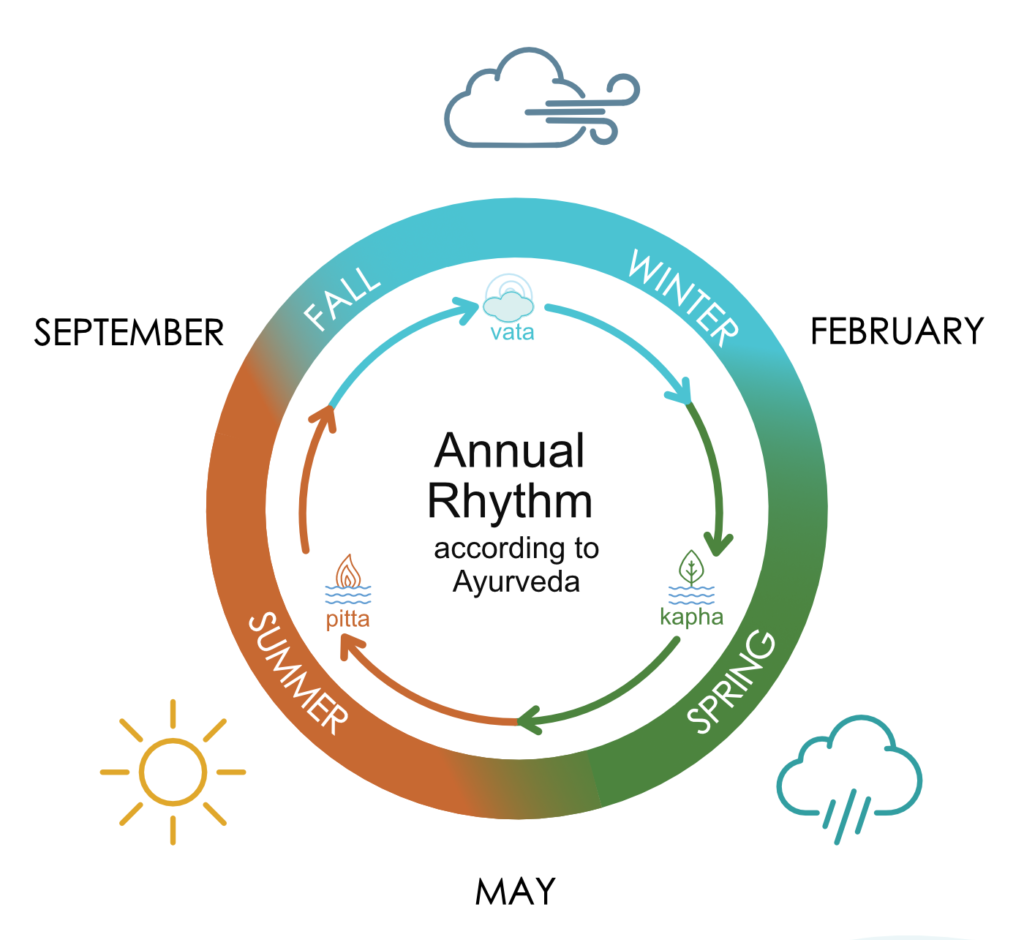
Seasonal changes impact the balance of the three doshas—Vata, Pitta, and Kapha—in different ways. Adapting your routine to the seasons can help maintain physical and mental equilibrium. Ayurvedic practices for seasonal changes offer guidance for aligning your lifestyle, diet, and self-care with nature’s cycles, promoting health and wellness year-round. Learn more about Ayurveda and its benefits.
Kapha Dosha in Spring (Kapha Season)
Spring is Kapha season, characterized by heaviness, moisture, and cool temperatures. For those with dominant Kapha, or anyone experiencing a Kapha imbalance during spring, Ayurveda emphasizes the importance of lightening up and staying active.
- Diet: Opt for warm, light, and dry foods to reduce the excess Kapha. Include bitter, pungent, and astringent tastes—like green vegetables, ginger, and turmeric—in your meals. Avoid dairy, fried foods, and sweets, which can aggravate Kapha.
- Exercise: Increase your physical activity with invigorating practices like brisk walking, yoga, or cycling. Morning exercises are particularly beneficial to keep Kapha energy in balance.
- Self-care: Dry brushing and warm oil massages with mustard or sesame oil can stimulate circulation and help alleviate sluggishness.
Pitta Dosha in Summer (Pitta Season)
Summer is dominated by Pitta energy, which is hot, intense, and sharp. Ayurvedic practices during summer aim to cool and soothe the body and mind, particularly for those prone to Pitta imbalances.
- Diet: Eat cooling, hydrating foods like cucumbers, melons, leafy greens, and coconut. Favor sweet, bitter, and astringent tastes, and avoid spicy, salty, and sour foods that increase heat.
- Exercise: Choose gentle, cooling exercises like swimming, evening walks, or yoga during the cooler parts of the day. Avoid strenuous activities during peak heat.
- Self-care: Apply cooling oils like coconut or sandalwood oil for self-massage. Spend time in the shade and avoid excessive exposure to the sun.
Vata Dosha in Autumn (Vata Season)
Autumn is the Vata season, characterized by dryness, coolness, and variability. Vata dosha, linked to the air and space elements, can become imbalanced, leading to feelings of anxiety, restlessness, and dryness. Ayurvedic practices during this season are focused on grounding and warmth.
- Diet: Favor warm, cooked, and nourishing foods like soups, stews, and root vegetables. Sweet, sour, and salty tastes help pacify Vata. Use warming spices like cinnamon, cumin, and cardamom in your meals.
- Exercise: Gentle, steady exercises such as yoga, tai chi, or walking help keep Vata in check. Avoid over-exertion and opt for consistent, routine-based activities.
- Self-care: Abhyanga (oil massage) with warm sesame or almond oil provides hydration and grounding. Establishing a regular routine is essential to calm Vata’s erratic nature.
Balancing the Doshas Year-Round
Regardless of the season, it’s important to stay mindful of the dominant dosha affecting your body. By adjusting your diet, self-care routine, and lifestyle according to the season, you can keep your doshas in balance and maintain optimal health .Learn more about Doshas.
Conclusion
Ayurvedic practices for seasonal changes help you align your daily routine with nature’s rhythms, balancing the doshas as the seasons shift. Whether you need to pacify Vata in autumn, Pitta in summer, or Kapha in spring, incorporating these Ayurvedic recommendations into your life can promote balance and well-being year-round. Learn more about how to tailor your Ayurvedic practices to the seasons for enhanced health and vitality.

[…] For more on maintaining dosha balance during weather changes, read our post on Seasonal change and ayurvedic practice for optimal health. […]
[…] Seasonal Eating: Aligning food choices with seasonal changes to maintain dosha balance (Ritucharya). Learn more about Seasonal Eating here. […]